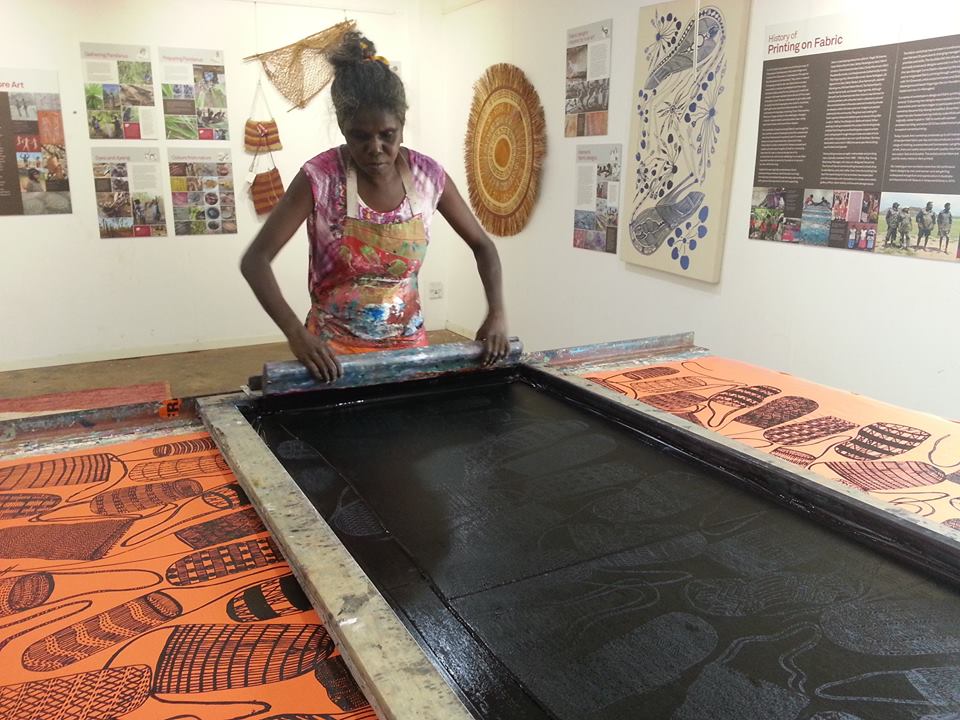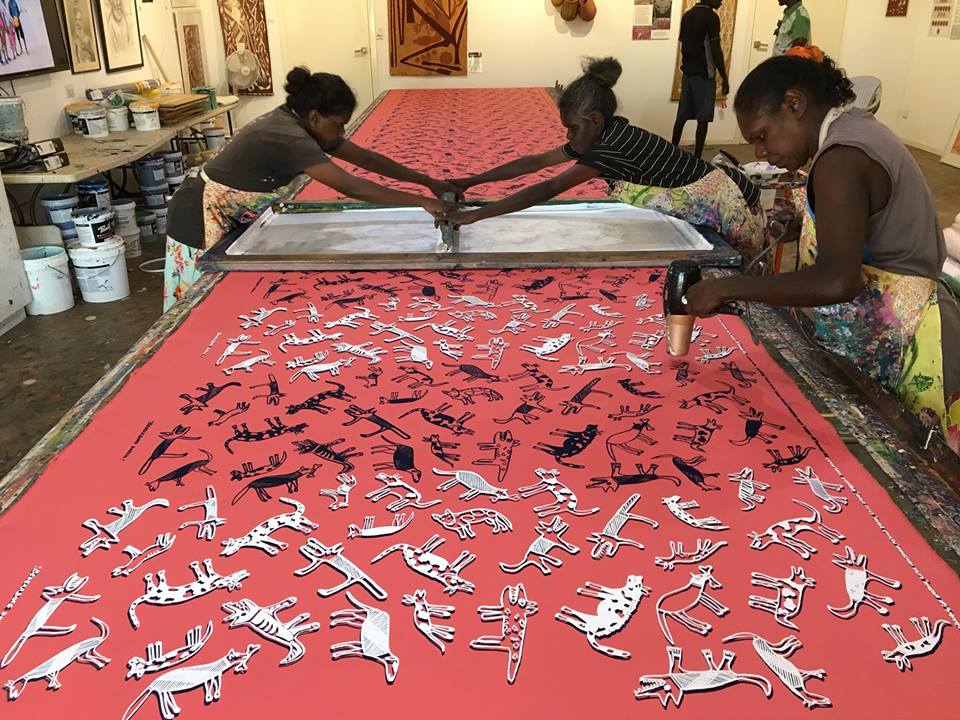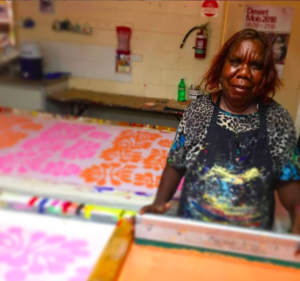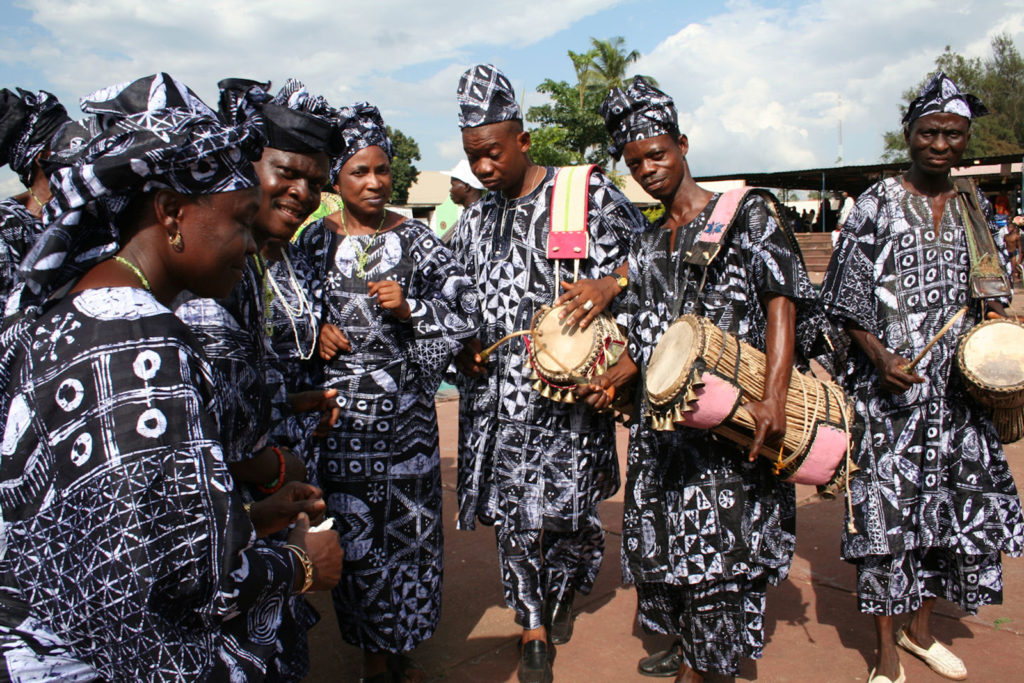Hand printed fabrics
The amazing world of Australian ATSI hand printed fabrics
Photo above: Reuben and Daniel hand screen printing Marebu (mat) design at Injalak Arts, Gunbalanya NT 2017
The last decade has seen an exciting explosion of creativity and production in Aboriginal and Torres Strait Islander (ATSI) remote community art centres. Although screen printing on fabric by art centres is not new (in fact it’s more than 50 years old, see below) it’s growing and gaining increasing recognition within Australia and around the world. Established and new remote community print workshops have been busy printing and creating a range of vibrant new designs (artworks) printed on fabric. There are currently around 20 art centres around the country involved in some form of fabric design and printing.
There are two main ways Indigenous designed fabrics are made: a) printed in a remote community or elsewhere using a hand screen or lino printing process and b) licensing of artworks for reproduction by an external partner, done offsite using a mechanised and/or digital printing process. In terms of the first one, screen printing is the most common and involves two people on either side of a table, the fabric stretched out, using a squeegee to push ink through a big screen with a stencil design. Hand screen printing is our area of speciality. Having said that, we are also happy to promote all Indigenous designs on fabric in Australia and beyond providing the process is ethical.

Whereas digital printing is a mechanised process, like printing with an ink jet printer but on fabric. It’s also very cool and you can get complex and very colorful prints and accurate copies of original paintings (for example). We champion all fabric/textiles that authentically and ethically celebrate Indigenous design and are particularly fond of the hands-on human printing process that not only generates livelihoods for printers but also is a joy to watch. My favorite part of every day as the Mentor Manager of Injalak Arts was the time spent in the print workshop with the printing teams and the excitement and satisfaction that comes from lifting the screen to see the image suddenly transferred to the fabric. The printers took so much pride and satisfaction in their work.
One of the passions driving Flying Fox Fabrics is educating consumers about hand printed fabrics. Our founder has been doing that for a very long time, in fact she wrote the submission for Desart Inc. to produce the first ever book focusing on Aboriginal fabric textiles: Putting in the Color back in the mid 1990s. If you are doing something related to Indigenous fabric design and would like us to promote you by sharing your story on our website or blog – get in touch!

A brief overview of hand-printed fabrics from remote ATSI communities
More than 50 years ago hand printing on fabric using silk screens was started on Bathurst Island, around 90 km north of Darwin, by Tiwi people. Since then a number of mainland art centres have joined the two pioneers Tiwi Design and Bima Wear both located in Wurrumiyanga community. A huge congratulations to Bima Wear that celebrated its 50th Birthday in 2019 and here is a video of the ladies celebrating with a dance at Government House in Darwin.
Art centres printing fabric onsite

Many of the most active art centres that design/print/dye fabric onsite are in the Northern Territory including: Babbarra Designs in Maningrida, Injalak Arts in Gunbalanya, Merrepen Arts in Nauiyu, Ikuntji Artists in Haasts Bluff, Jilamara, and Munupi Arts on Melville Island and Anindilyakwa Arts on Groote Eylandt. Some Northern Terrtiory art centres go through periods of activity including Palngun Wurnangat in Wadeye, Bula’bula Arts in Ramingining, Ngukurr Arts in Ngukurr and Djilpin Arts in Beswick. In Western Australia we find Nagula Jarndu, Waringarri Arts, and Mangkaja Arts. In Queensland there are Erub Arts and Hopevale. Check out the online stores many of these art centres have. If you know of any not included here – let us know!

Adire from West Africa
Flick has a strong connection with Nigeria and has become increasingly interested in traditional printed and dyed fabric from West Africa. The tradition of indigo dyeing goes back centuries in West Africa. The earliest known example is a cap from the Dogon kingdom in Mali dating to the 11th century. Resist dyeing has long been used to achieve simple and complex patterns with a variety of techniques including Onikan (a form of tie-dyeing) and Alebere (stitching raffia into the fabric). In Nigeria Adire Eleko is resist dyeing with cassava paste painted onto the fabric. Traditionally done with different size chicken feathers, calabash carved into different designs are also used, in a manner similar to block printing. Since the early twentieth century, metal stencils cut from the sheets of tin that lined tea chests have also been used and brushes. In contemporary practice wax often replaces cassava paste and a subtle palette of indigo has been usurped by bright inorganic dyes. Adire Eleko is the original “African wax” rather than the mass machine produced bright fabrics (often designed and printed in Europe) that have become known by that name. Read an interesting article about Adire here.

